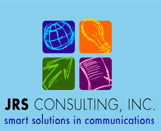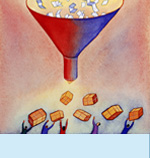Eight Brainstorming Best Practices:
How to Ensure Super-Colossal Ideas
When I worked in public relations firms, I held some of my best brainstorming sessions ever as well as some of my least productive sessions. The best brainstormings were exciting, stimulating and fun. They generated big ideas that won us business. The least productive sessions were flat, anxiety-filled and frustrating. Where were those elusive big ideas?
Both the most and least productive sessions had one major aspect in common – I had organized them because I was under the gun to come up with a super-colossal idea for a potential or existing client. So when they didn't go well, I was tearing my hair out wondering what to do.
Years later, having facilitated hundreds of brainstorming sessions and studied facilitation and creativity, I have realized that effective brainstorming is no accident. Whether you're seeking the development of a new mission statement, strategizing how to structure your organization more effectively, or in pursuit of a super-colossal idea, there are definite ways you can help ensure the productivity of your meeting.
Following are eight recommendations for maximizing the success of your brainstorming or creative session, based on hundreds of sessions we have conducted for organizations of all sizes:
Size matters. So does who you're doing it with. Alright now, keep it clean. We're talking about brainstorming here.
There is a "magic number" for brainstorming and that number is 8-10 people. If you get more than ten people, it becomes challenging for everyone to participate and it's too easy for side conversations to get going. If you are in a situation where you feel you must have more than 10, consider holding two separate brainstorming sessions. Or, break the larger group into simultaneous sessions, each with its own facilitator. Then have the larger group get back together and debrief.
I have also held effective creative sessions with as few as six participants, providing those participants are truly committed to the task at hand. This brings me to my next point – it's important to choose participants carefully.
While it's true that everyone has good ideas, the right combination of people can really increase the productivity of your brainstorming. As you put together a brainstorming meeting, consider including a mix of subject matter experts – people who work on the business closely and know it very well – along with users or potential users of the product or service, and people who are just plain creative but may not know much at all about the matter at hand. This combination of expertise, creativity and target users is ideal for generating great ideas.
Put some "oomph" into your setting. I can't tell you how many brainstorming sessions I attended when I worked for public relations firms that were held in windowless conference rooms, late in the afternoon, without refreshments or any sort of stimulus to inspire creativity. At those types of meetings, the only adrenaline in the room was usually located in the poor person holding the session who was under pressure to come up with a big idea because the account was up for review.
When possible, consider going off site for a session. The change of scenery will spark new thinking and you'll really get your participants' attention. One of the most interesting settings in which I held a brainstorming session was in a conference room surrounded by windows at the top of the Aon Center in Chicago. With 83 floors, the Aon Center is the third tallest building in Chicago and the view from that room was incredible. That room was full of energy and fun, and the ideas we generated reflected our enthusiasm for being there.
However, budget and other considerations won't always permit bringing a group to an outside location. That's when you can get creative about enhancing your existing facilities. What can you do to inspire creativity and make the meeting fun and productive? Try some of the following:
• Decorate the room as appropriate. Do you or your client have advertising you can post on the walls? Can each participant receive some little gift or something to wear (i.e. sunglasses, plastic beads) that supports the theme of the meeting?
• Serve snacks. Creativity takes energy. Put out a fruit tray, bowls of candy or cheese and vegetables and dip. Always have pitchers of ice water on hand or bottles of water.
• Give everyone a legal pad or stack of paper along with colored markers (the 8-packs that kids get for school).
• Have little toys and gadgets out on the table for participants to play with.
• Have 1-2 flip charts for your own note taking and an assortment of colored markers. Tip: Look for the post-it flip charts that you can tear off and post on the wall when it's time for a new flip chart page. That way, you and your participants can continue to see what you've already developed.
Begin with an ice-breaker. Whether all of the brainstorming participants know each other or not, a warm-up exercise will bring the group together, help people to feel comfortable with each other and provide a transition to the task at hand.
When I'm planning a creative session, I always try to design a warm-up technique that involves the participants with our objective for the day. For example, when I facilitated a session recently for a youth organization that wanted to develop a new mission statement, I asked the participants, who were also the board of directors, to tell the group, one at a time, about an experience they had as a child that they felt had really influenced them. The experiences shared were fascinating, even to board members who had known each other for some time. The exercise set a warm, supportive tone for the meeting that enabled our objective for the day.
Say, "Yes!" Nod… Smile… Sometimes applaud. This is really important – be enthusiastic about every idea. At the start of the session, tell participants that baby ideas can grow into big ones and that it's critical to listen enthusiastically and try to build on the ideas of others. Then model this behavior in the session for others to see and duplicate.
The facilitator should write down every idea – even those that don't seem appealing. That sends the message that every idea matters.
Do you ever have trouble keeping up with writing ideas? Here's a tip: After someone makes a suggestion, ask him or her to elaborate on the idea to give yourself a little more writing time. Try repeating the idea and saying, "How would that work?" Or, "Say a little more about that."
Consider separating the roles of facilitator and client. When I first began facilitating brainstorming sessions, I was both the facilitator and the client because I was seeking ideas for the accounts that I directed. However, as the previous point conveys, the facilitator role is really important. It is challenging to moderate effectively if you also need to concern yourself with the specifics and nuances of the session content.
For that reason, I advocate that the client or "problem owner" designate someone else to actually conduct the creative session – whether a colleague trained in facilitation or an outside facilitator. The facilitator can then ask the client to provide an overview of the situation at the beginning of the session and check in periodically with the client to make sure the session is on track or to respond to specific questions.
Go for quantity, not quality – at least initially. As you brainstorm, seek the largest volume of ideas you can generate. Ask participants to call out whatever comes to mind. Tell them that at this point, you are most interested in obtaining a large quantity of top-of-mind ideas and aren't concerned about complete thoughts or logistics – that will come later.
Here are two tips I learned from my friend, Sharon Livingston of The Livingston Group: It may seem obvious, but the most productive suggestion that a facilitator can make to a creative session is actually to, "Be creative." This seems to give people permission to think creatively. Also, if a participant says, "Gee, I don't know," try responding matter-of-factly with, "What if you did know?" You will be amazed at the responses enabled by your comment.
Encourage quantity by writing every idea on the flipchart and responding enthusiastically to each one – actually repeat each aloud and be as positive as you can. Continually ask, "What else?" "Other ideas?" Do this until the idea flow slows down. Which brings us to the next recommendation…
If people get stuck and can't think of any more ideas, help them with a freeing activity. People call this technique all kinds of things – "In and Out Thinking," "Mental Vacations," "Excursions." The idea behind these is to encourage the group to think of something unrelated to the task at hand and then direct them to relate it back to the focus for the meeting.
Here's how it works: Give the group an assignment of thinking about something else entirely – you designate what that is to be. Similar to the warm-up exercise, it can be helpful to try to make the assignment somehow related to the creative session's content. For example, in a brainstorming session to generate promotional ideas for a children's product, participants might be asked to reflect on one of their favorite books as a child. Consider asking them to close their eyes as they do this. Give them three minutes or so to visualize the book. Then, bring people back to the moment by asking them to think about what ideas come to mind for the current meeting, based upon their mental voyage. This technique is guaranteed to spark some new thinking.
At the end of the session, ask participants to help you with identifying their "favorite ideas." You can do this by distributing "sticky dots" and asking participants to vote, followed by a discussion about why these ideas were their favorites. If desirable, you could involve participants further by asking them to flesh out the selected ideas or you might choose to have a follow-up meeting with the client team to explore the selections.
This last step helps bring some closure to your creative exploration, and gives participants the chance to "reel it back in" with selecting the ideas they consider to be the strongest.
These eight best practices will leave less to chance when you are faced with the challenge of developing a super-colossal idea. A productive framework for a brainstorming session will gently direct the group to be both productive and creative.
NEXT ARTICLE
Jenny Schade is president of JRS Consulting, Inc., a firm that helps organizations build leading brands and efficiently attract and motivate employees and customers. Subscribe to the free JRS newsletter on www.jrsconsulting.net/newsletter.html
© JRS Consulting, Inc. 2007





